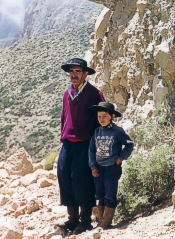
Argentine father and son, in
native costume, in the
Andes Mendoza wine region | Argentina: A World-Class
Great Bargain Destination By Sally Ogle Davis and Ivor Davis  N a first visit to Argentina two stark and contrasting facts are immediately apparent: The pitiful state of the local economy and the absolute bonanza of travel bargains on offer for North American tourists. N a first visit to Argentina two stark and contrasting facts are immediately apparent: The pitiful state of the local economy and the absolute bonanza of travel bargains on offer for North American tourists.
Friends told us about making hotel reservations in Buenos Aires for $200 a night which when they arrived were now $80—same hotel, same room, different exchange rate. Once, the peso was pegged—one to one–to the US dollar. But with the peso devalued in December 2001 to a third of its value, a middle class population that put their savings in the bank in US dollars and got them back in pesos, and a government that doesn’t even bother to hide their corruption anymore, Argentina has fallen upon very hard times. But there’s no need to feel guilty if you take advantage of this sorry state of affairs to take your next vacation in the Big Apple (Buenos Aires that is, not New York). Everywhere we went people urged: “ Bring us tourists.” And it is to tourism and wine the country is looking to get them out of the worst recession in a century. Most tourists start into Buenos Aires, but we were headed first to the wine country of Mendoza, the province in the northwest closer to Chile than to any city in Argentina. We wanted to experience what we’d been told was the magical drive across the Andes into Argentina. So we flew on a wide-bodied Lan Chile jet to Santiago. After a short rest, we started the 365 kilometer climb over the highest mountain range in the Americas. This road of sheer drops and hairpin curves is not for the faint of heart but the scenery more than lived up to its billing. It was in 1561 that the first Spanish conquerors used this road from Chile to found Mendoza. Today climbers come from all over the world to scale Aconcagua , the highest mountain in both the Southern and the Western Hemisphere. We were overwhelmed by the sheer magnificence of the mountains. As the snows start to melt in the spring (our fall), spectacular waterfalls line the route. The rock formations are staggering in their range of colors. Nevertheless, it was almost a relief to descend, after a six-hour drive, from the mountains into the bucolic landscape of Argentina’s Mendoza province—land of green orchards and vineyards stretching across a vast alluvial plain, ending abruptly at the sheer rock wall of the Andes. As far as the eye can see, the alluvial plain is quickly filling up with vineyards dotted among orchards of plum, apricot, peach, apples, quince, walnuts and almonds all ready to supply North America in winter when our sun fades and the summer fruits dry up. 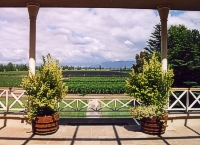
The spectacular Salentein vineyard
in the foothills of the Andes in
Argentina | This country was endowed by its creator with the most fertile most beautiful land in all of South America, and it became a melting pot where immigrants from Italy and Spain, brought with them along with their work ethic, their agricultural knowledge, especially of wine growing. By the 19th century, Mendoza was selling wine to the rest of Argentina and sending barrels in horse carts across the mountains to Chile. Soon Argentina, a country four times larger than Texas and five times the size of France. became the fifth largest producer of wine in the world and the third largest per capita consumer after Italy and France. Here’s the rub: There was little incentive to improve the quality of the wines from the rough table stuff favored by the locals because they drank everything they could produce themselves. Not any longer. Now with Argentina in dire financial straits, wine exports could be their salvation. Foreign capital is pouring into the Mendoza Valley as industrialists and entrepreneurs race each other to invest in what they see as the coming boom. If 100 percent of the available wine growing land was producing, Argentina could exceed the outcome of France and Italy put together. Extravagant state of the art wineries in various stages of construction already dot the landscape. Our destination was one of the grandest wineries—Bodega Salentein with Dutch capital and a local president, Carlos Pulenta, whose family has been making wine in this valley for almost 100 years. Salentein have planted thousands of hectares of Malbec—the rich grape that came unappreciated from France and became the Argentine favorite (think a richer, more dense Merlot) as well as Cabernet, Merlot and Shiraz. Their wine maker Laureano Gomez with the advice of a visiting big shot, the renowned French enologist Michel Rolland who visits Salentein five times a year, is even experimenting with Pinot Noir on the lower foothills of the Andes. 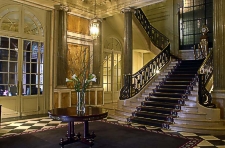
Elegant beaux arts mansion at the
Four Seasons Hotel in Buenos Aires | The Salentein winery, an imposing stone building, is built in a cruciform—hence the local name for it “a cathedral of wine.” Its interior designed by Bormida and Yanzon, a leading Buenos Aires firm, in which the four wings of the cross converge in a circular amphitheater lit mystically from above by a huge skylight, looks as if virgins might be sacrificed at midnight masses. But this is a temple only to the god of wine. After a tour, we sat tasting the rich reds in which the concentration of fruit was almost overwhelming, as we admired the immensity of the mountains through a large picture window, appropriately so since the vineyards are irrigated with pure water from the melting snows of the peaks. Posada Salentein in the middle of the vineyards provided a comfortable base for some serious wine tasting around the area. This small country inn with simple but comfortable rooms with breakfast and dinner included was ours for a rate of $55 per person per night. (For details check their website: www.bodegasalentein.com.) From here we can arrange trips for hunting, fishing, skiing , rafting, horseback riding, parasailing, off road desert riding, mountain climbing, rappelling. We just about managed a hike in the Andes foothills, where a small military outpost near the Chilean border greeted us like long lost friends. In fractured Spanish with lots of arm waving and broad smiles we talked international soccer. An hour from Mendoza and we were in a different world: Buenos Aires airport right in the heart of town. Within minutes we were relaxing in our hotel room. With the dollar so powerful, we decided to sample the very best Buenos Aires has to offer: The Four Seasons. With top hotels searching for guests—local businessmen can no longer afford to travel—they have come up with a package which was too enticing to turn down even though our budget does not normally run to Four Seasons. For $1,000 we found a remarkable package: three nights at the Four Seasons BA in La Recoleta, the city’s most fashionable district, and then three nights at their Carmelo resort just across the Rio de La Plata in Uruguay. To get to Carmelo you take a 15-minute flight by private plane or an hour ride on a high speed ferry, The Buquebus, followed by a 50-minute road trip to the resort in the Uruguayan countryside, for three more nights at this gorgeous country lodge, with golf course and spa. (Phone: 54 (11) 4321 1200 or check their website: www.fourseasons.com.) In BA, the Four Seasons is actually two hotels in one—a modern highrise in front and behind—a magnificent Beaux Arts Mansion, built in 1916 by an Argentine businessman for his new bride, and sympathetically restored with its Louis X111 inspired gilt moldings, high ceilings, and imported parquet floors in tact. The celebrity jet set from Madonna to Melanie Griffith and Antonio Banderas, and the hotel’s personal favorite Emma Thompson, favored the Mansion while they were filming in BA. A city like Buenos Aires, that produced the tango and Eva Peron, knows a thing or two about seduction. Despite their difficulties it’s still all too easy to be seduced by BA, though it’s enormously difficult to leave a fine restaurant late at night to find children going through the bagged garbage in the upscale neighborhoods looking for things they can recycle or sell. For the tourist, everything produced locally is guilt-inducingly cheap. Food is superb—and the prices unbelievable. The Four Season’s chef Ashley James, who hails from Wolverhampton, England, presides over a kitchen full of fresh ideas and even fresher produce. Unfortunately it is not getting the attention it deserves because of the economic downturn. Alhough the hotel is at the top of the price tree in the city, a business lunch at the hotel—an elaborate antipasto buffet , a la carte main course, dessert coffee or tea—costs a mere 13 U.S dollars. At the other end of the scale, on advice of the hotel’s general manager, we sought out something simpler: Guerrin on Avenue Corrientes l368 (no reservations needed), the oldest pizzeria in BA, owned and operated by the same Italian family for over 100 years. 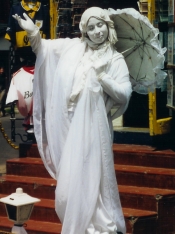
Mime artist in downtown
Buenos Aires | There wasn’t a tourist in sight as we sat crammed in with the locals on a warm night in a crowded restaurant with fans whirring overhead and the waiters greeting the regulars like old friends. We shared a giant pizza, with a large salad, another order of empanadas, a half bottle of wine, a beer, and two flans for dessert—all of it wonderful and the bill came to $6.50—Yes, that’s six dollars and fifty cents. Doing everything in three days in BA was impossible. To help us maximize our time, we used the services of a guide at $25 an hour. While that may sound pricey by Argentine standards, Evelyn Kollmann of Viennese descent and an English teacher, was well worth the money. A car and driver is included in the price. (Her email address is: evelynkollmann@fibertel.com.ar) Our first stop had to be the Recoleta cemetery and the tomb of the Duarte family. Never heard of the Duartes? Their most famous offspring—even though she was illegitimate and not, strictly speaking, entitled to the name—was one Eva Duarte, the poor girl from the sticks who married the dictator Juan Peron and became a combination bitch goddess and saint. (The Andrew Lloyd Webber musical about her life was a smash hit around the world.) The best informed Argentines will tell you that it was Eva and Juan who started the rot in the country by paying the peasants with handouts so that they stopped working the land and learned to rely on the government who let them down in the end. The cemetery is a city built to house the blue bloods of Argentina who have passed on. The tombs are grandiose villas for the dead, some of whom are undoubtedly spinning in their marble sepulchers at the idea that they have found their final resting place alongside the upstart woman they so despised when she was alive. Another must see is Casa Rosada (so called because originally it was plastered with a substance made of mud and colored with ox blood.) It stands in the Plaza de Mayo, still pink though this time from a more conventional paint. It’s where Juan and Eva waved to the masses gathered below and where director Alan Parker shot Madonna as Evita for his 1996 movie musical. Still the seat of a government universally despised, the building is protected by barricades to take care of the crowds who protest in the square daily. Anti government graffiti decorates almost all the civic buildings in the square. Nobody bothers to paint it over; it would simply appear again the next day. Every Monday “the grandmothers,” relatives of those who disappeared under the l976-83 military dictatorship, march in a circle while the crowd looks respectfully on. Today the grandmothers are outnumbered by the homeless and the unemployed. In search of something more cheerful, we moved on to La Boca, one of the most colorful areas of the city down by the old port where immigrants from Genoa were disgorged from rickety ships in the late 1800s, and set up homes and restaurants along the waters edge. Today the Italians have mostly moved on, leaving the highly colored houses, many of them built of the original corrugated tin and painted in primary colors , to artists, painters, sculptors and entertainers. There are the ubiquitous tango dancers–it was from the bars and brothels of the area that this most Argentinian of all art forms sprang—mimes, living statues , performing dogs and all the rest of it. Think New Orleans at bargain prices. The art is colorful and often skilled. Here’s the place to buy an original oil or watercolor of typical Argentine scenes for as little as $10. For more sophisticated souvenirs, the Feria at San Telmo takes place on Saturday and Sunday throughout the year. This antique district, 11 blocks of Avenida Florida , the main shopping street of BA, has cobbled lanes lined with antique shops, restaurants, coffee houses. It is also home to the National Historical Museum. Weekend visitors make a beeline for the squares, filled with peddler’s stands, where treasures can include everything from old tango sheet music, to gold and silver jewelry to small silver pieces from the arts and crafts , deco and Beaux Arts period. The stores house some of the finest art deco furniture and silver I have ever seen outside a museum but the bargains are on the street. I brought home a silver gravy boat and saucer in the Mackintosh style in perfect condition for $80. 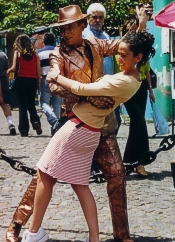
Tango dancers give visitors
free lessons on the street | Much of this loot of course comes from the homes of middle and upper class families who have sold whatever they can just to stay afloat. With pensioners existing on under $80 a month and surgeons earning less than $200 a month, the hurting is across the board. Gone are the days when the Argentine rich traveled to the capitals of Europe with their own cow in tow for milk because they found European dairy products inferior. Gone too are the days when Argentines, because of their European origins, lorded over the rest of South America as the best dressed, best educated most sophisticated country on the continent. But BA still feels more Paris than Rio, albeit Paris with Cuban prices. And though in need of a face lift—something that requires more money than the old dowager can currently put her hands on—Evita’s city is still the sexy capital of an immensely attractive country. Go see it while the bargains are hot. |